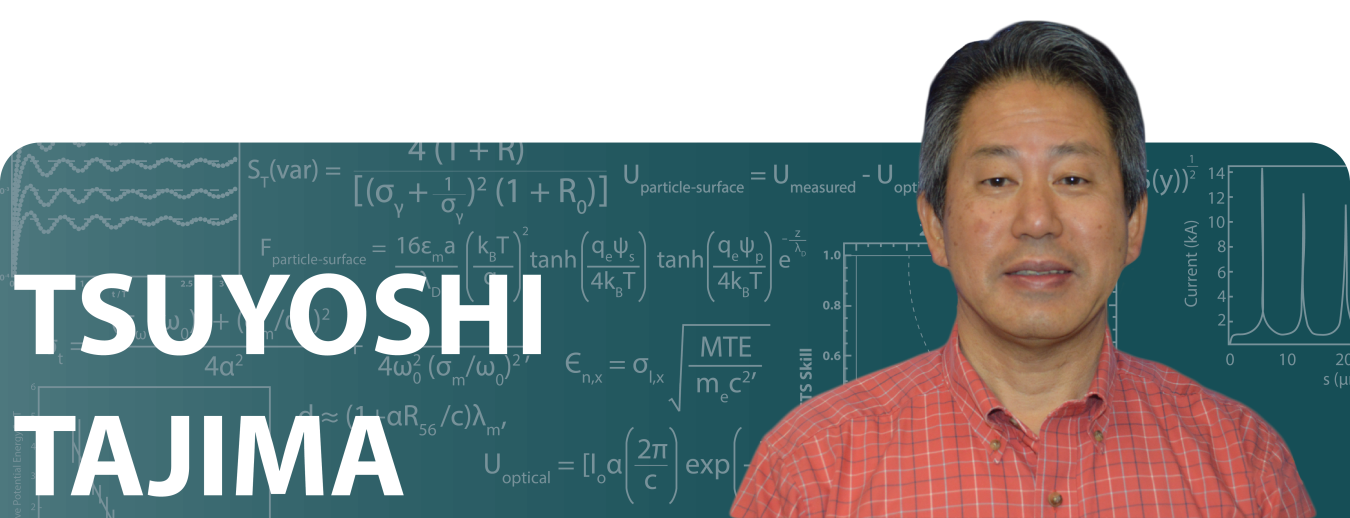Tsuyoshi Tajima at Los Alamos National Lab is investigating the promising potential of MgB2 to coat particle accelerator components.
March 13, 2020
WHAT DID THE 2010 EARLY CAREER AWARD ALLOW YOU TO DO?
Particle accelerators are invaluable tools for advancing the current state of science, engineering, and technologies. However, they are expensive and need a large area of real estate to be built.
Superconducting radiofrequency (SRF) structures, a core component of the accelerator to accelerate bunches of particles such as electrons and protons, have helped reduce the cost. They are increasingly popular for new projects. Since the 1980s, superconducting niobium (Nb) has been the best material of choice for accelerator cores.
This Early Career Award made it possible to evaluate other superconductors that might be able to exceed the performance of Nb structures. The material we have found to be most promising is magnesium diboride (MgB2). MgB2 was discovered to be superconductive at 39 K, about four times higher than possible with Nb (9.3 K). This potentially enables us to run the accelerator at a higher temperature more economically. Additionally, the theoretically predicted achievable gain of particle energy per unit length (accelerator gradient) is significantly higher than with Nb. This potentially enables us to make more compact accelerators.
Based on the knowledge obtained through these studies, the MgB2 coating system is being designed. We hope that MgB2 will be part of the next generation of SRF technologies that embodies further cost reduction and smaller accelerators.
ABOUT:
Tsuyoshi Tajima is a research and development engineer and a team leader in the Accelerator Operations and Technology Division at the U.S. Department of Energy Los Alamos National Laboratory.
SUPPORTING THE DOE SC MISSION:
The Early Career Award program provides financial support that is foundational to young scientists, freeing them to focus on executing their research goals. The development of outstanding scientists early in their careers is of paramount importance to the Department of Energy Office of Science. By investing in the next generation of researchers, the Office of Science champions lifelong careers in discovery science.
For more information, please go to the Early Career Research Program.
THE 2010 PROJECT ABSTRACT:
Technology Development toward Very High‐Gradient and High Quality‐Factor Superconducting RF Cavities
The goal of this research is to produce a prototype multi‐cell superconducting radiofrequency (SRF) cavity for particle accelerators that generates an accelerating gradient of 100 megavolts/meter (MV/m) or higher with a quality factor of 2E+10 or higher. Current niobium technology used in SRF cavities has a theoretical limit of 50‐60 MV/m, and a new technology needs to be developed for advanced accelerators. This project will use a thin film technology to achieve the improvement taking advantage of the phenomenon that the lower critical field is increased for a thin‐film superconductor material. If successful, the new cavity technology will enable smaller, more energy‐efficient and cost‐ effective particle accelerators.
RESOURCES:
T. Tan, M.A. Wolak, X.X. Xi, T. Tajima, and L. Civale, “Magnesium diboride coated bulk niobium: a new approach to higher acceleration gradient.” Scientific Reports 6, 35879 (2016). [DOI: 10.1038/srep35879]
T. Tajima, L. Civale, D.J. Devlin, R.K. Schulze, I.O. Usov, and G.C. Martinez, “Status of MgB2 Coating Studies for SRF Applications.” Proc. 16th International Conference on RF Superconductivity (SRF2013), Paris, France, 23-27 September 2013, p. 777. http://accelconf.web.cern.ch/AccelConf/SRF2013/papers/weiob01.pdf
T. Tajima, L. Civale, R.K. Schulze, “Research on MgB2 at LANL for the application to SRF structures.” The 17th International Conference on RF Superconductivity (SRF2015), Whistler, BC, Canada, 13-18 September 2015, p. 700. http://accelconf.web.cern.ch/accelconf/srf2015/papers/tupb053.pdf
Additional profiles of the Early Career Research Program award recipients can be found on the Early Career Program Page.
The Office of Science is the single largest supporter of basic research in the physical sciences in the United States and is working to address some of the most pressing challenges of our time. For more information, please visit www.energy.gov/science.
Sandra Allen McLean

Sandra Allen McLean (sandra.mclean@science.doe.gov) is a communications specialist for the Office of Science in the Office of Communications and Public Affairs. Sandra is responsible for identifying, curating, or creating lay-language content about Office of Science-funded research for DOE web sites, popular and trade media, and stakeholder education. She researches and writes the historical Milestone Tweets for the office Twitter account @DOEScience.
Sandra holds an associate degree in American Sign Language interpreting, a bachelor’s in science journalism and biology, and a master’s in Information Sciences. Her hobbies are sewing – especially costumes! – and lesesucht, compounded by extreme tsundoku.


